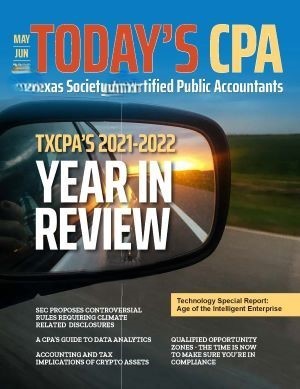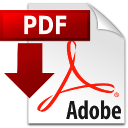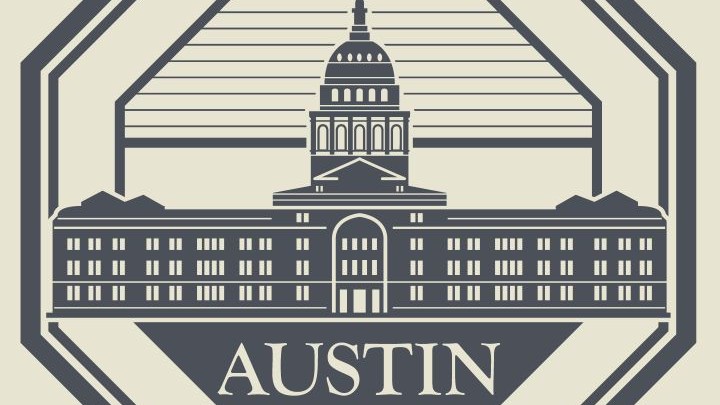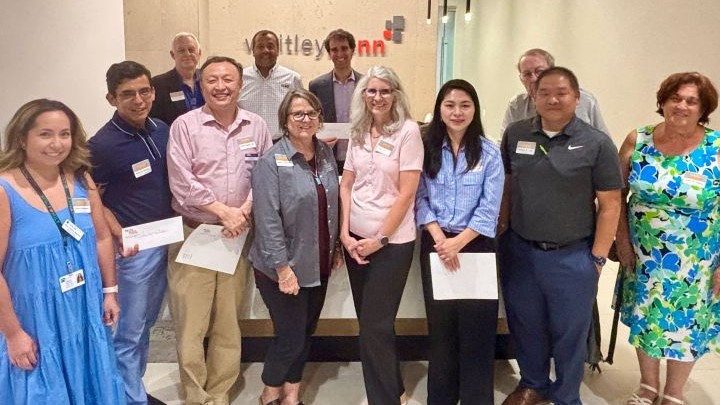Invested in Qualified Opportunity Zones?
TAX TOPICS
The Time is Now to Make Sure You’re in Compliance
By Katherine Noll, J.D., LL.M., B.B.A.
The Qualified Opportunity Zone (QOZ) tax incentives were established as a part of the 2017 Tax Cuts and Jobs Act and were created to allow taxpayers to reinvest preexisting capital gains into designated low-income areas in exchange for tax benefits.
Qualified Opportunity Zone Funds continue to be an investment alternative offering substantial tax benefits for investments made by the end of tax year 2026, but the publication of a recent report issued by the Treasury Inspector General for Tax Administration, as well as a concurrent probe by Ron Wyden, Senate Finance Committee Chair, indicates compliance will be key going forward.
Background Information
To connect investor capital with low-income areas of the country designated to have the greatest need for reinvestment, Subchapter Z of the Internal Revenue Code (the Code), titled Opportunity Zones, came into effect in January of 2018, adding tremendous tax incentives under Section 1400Z-2 for qualifying capital gain investment in Qualified Opportunity Zone Funds (QOF or QOZ Fund).
A QOF is a special purpose entity that is formed for the purposes of investing in Qualified Opportunity Zone Property (QOZ Property) and is taxed as a partnership or corporation. The tax benefits were threefold:
- The deferral of recently generated capital gains until tax year 2026 by investing the gains in a QOF within 180 days of the disposition event generating the gain;
- Partial elimination of the capital gains invested in the QOF through a step-up in basis of 10% if the investment in the QOF is held five years by 2026 and an additional 5% (for a total 15%) if the investment in the QOF is held seven years by 2026; and
- Tax-free appreciation of the capital gains invested in the QOF upon the sale of the investment if it is held for at least 10 years in the QOF through a step-up in basis to the fair market value of such investment on the date the investment is sold.i
The tax benefits only apply to capital gains that are deferred through investment in a QOF; after-tax investment in a QOF does not qualify for any of the tax benefits. And, as the benefit of tax-free appreciation requires the investment to be held for at least 10 years, there will be a phantom tax event in 2026 (although certain debt-financed distributions are permitted). Thus, taxpayers must be mindful of the liquidity needed to meet the upcoming tax obligation for tax year 2026.
The requirements on a QOZ Fund investment are restrictive, tedious and complex. The final regulations and preamble totaled 544 pages on original release and are designed to work with a real estate development project located in a designated QOZ or a start-up business operating in a QOZ.ii A QOZ Fund must hold at least 90% of its assets in QOZ Property and must be structured as either a direct investment by the QOF in QOZ Business Property or an investment through a subsidiary entity that meets the requirements of a Qualified Opportunity Zone Business (QOZ Business) and that entity owns or leases the QOZ Business Property (with most QOZ investments structured under a two-tier entity structure).iii
Any gain that is treated as a capital gain for federal income tax purposes is eligible for the QOZ tax benefits, including long-term and short-term capital gains, qualified gains under Section 1231 and 1250 gains.iv Thus, a business owner selling their business could receive incredible tax benefits if desiring to invest in real estate or a start-up business located in a QOZ.
Like with Section 1031 exchanges, investment in a QOF must be made within 180 days of the gain event, but unlike Section 1031, if the gain is generated through a pass-through entity, the 180 days starts on the sale transaction date, December 31 of the year of sale, or the due date of the pass-through entity's tax return, without extension. Thus, real estate investors who have entered into a Section 1031 exchange that failed the 180-day requirement may utilize the more favorable timing rules for a QOZ Fund investment.
Following the spirit of the law, Code Section 1400Z-2 states that QOZ Property is tangible property acquired by purchase after December 31, 2017, and used in a trade or business of the QOF that must satisfy one of the following requirements:
- The original use of Qualified Opportunity Zone Property commences with the qualified QOF,
or - The QOF substantially improves the property.
The substantial improvement to the property is generally defined as taxpayers doubling the adjusted basis in the property after purchase and during any 30-month period that they hold their qualified QOZ Property, but IRS guidance provides nuances to how this is computed for various types of property.v
Notable additional requirements include:
- Strict prohibition of generating the invested capital gain from a related party or acquiring the QOZ Property from a related party;vi
- 50% income sourcing within a QOZ for a QOZ Business;vii
- The nonqualified financial property test that restricts a QOZ Business from holding nonqualified financial property (cash, debt, stock, partnership interest, options, and futures) to average less than 5% (except for a reasonable amount of operating working capital);viii
- The working capital safe harbor, which essentially permits a QOZ Business to hold cash during the development of a project or business for 31+ months (with up to an additional 24 months due to a federally declared disaster), but requires a specific written document and a schedule that meets the requirements of Treasury Regulations that is substantially followed;ix and
- Annual testing of the QOF on June 30 and December 31.x
Care should be given to drafting the working capital plan and schedule, as the Treasury Regulations do not generally provide that these documents can be amended, although proposed Treasury Regulations provide for amending a working capital plan for a QOZ Business operating in a federally declared disaster area for 120 days after the declaration lapses.xi Note that at the time of writing, the federally declared disaster due to COVID-19, originally issued on March 13, 2020, continues to be in effect.xii
OQZ Controversy – Senator Wyden’s Investigation
As previously noted, the policy behind the QOZ provision in the Code was to spur economic development and create jobs in designated communities that were considered distressed during the 2010 census by providing tax incentives to investors who made long-term investment into these communities. Due to concerns whether investments in QOZs are benefiting low-income communities rather than providing a tax-avoidance tool for wealthy individuals, Senate Finance Committee Chair Ron Wyden of Oregon launched an investigation into the operation and effects of QOZ Funds.xiii The senator has also previously introduced legislation to amend the statute.
In a letter sent to seven firms that invested in QOZ projects dated January 2022, Wyden noted that he has “long been concerned that the Opportunity Zone program may permit wealthy investors another opportunity to avoid billions of dollars in taxes without meaningfully benefitting the distressed communities the program was intended to help. …Currently, there are no safeguards or transparency measures in place to ensure taxpayers are not simply subsidizing high-end real estate investments by billionaires without demonstrating the benefit they are providing to low-income communities they claim to help.”
Unlike other government programs, Subchapter Z provides no formal job or economic tracking requirement for a QOZ investment. This lack of information has been cited as a criticism of QOZs, but the IRS has stated it needs Congressional authority to collect the data necessary to evaluate QOZ Funds and set guardrails.
With that said, Wyden specifically requested the firms provide detailed project information, including statistics on job creation and details regarding the business planning activities that occurred prior to the introduction of QOZs in December 2017, as well as any efforts made by the investors to solicit the designation of the QOZ utilized in the project.
The QOZ selection process involved governors submitting nominations of certain low-income census tracts by March 1, 2018, to the Secretary of the Treasury for certification and designation as an eligible tract under the terms of Section 1400Z-1. Notably, the census data used to determine if the tract qualified as a low-income community was almost 10 years old.
Regardless of the 2020 decennial census data, the 8,760 QOZ census tract boundaries listed in 2018 are confirmed as final and unchanged.xiv Thus, QOZ designations are permanent for purposes of Section 1400Z-1 and despite criticism, the statute would have to be amended by the U.S. Congress to change the QOZ tracts.xv
In his letter, Wyden noted several luxury real estate projects he finds problematic, including a marina in Palm Beach, hotels in Portland and New Orleans, and projects in Houston, Miami and Las Vegas, many of which he believed would have been developed absent the QOZ designation and tax benefits, in part because the area was already “booming.”
Compliance – A Major Issue
On February 7, 2022, following an audit initiated to confirm the IRS’s review process and to ensure that QOZ Funds meet the statutory requirements and reporting requirements for compliance for a QOZ investment, the Treasury Inspector General for Tax Administration issued a report titled “Additional Actions Are Needed to Address Qualified Opportunity Zone Fund and Investor Noncompliance,” which details that both qualified opportunity funds and investors often failed to provide the IRS with the required accurate information reporting to the IRS.xvi The report also listed additional actions that are needed to address QOZ Fund and investor noncompliance. It further notes that the IRS is developing a compliance plan to ensure the QOZ requirements are met.
Annually, QOZ Funds are required to submit Form 8996, Qualified Opportunity Fund, to certify to the IRS the QOF status, provide investment information and report to the IRS a penalty if the QOF fails the 90% investment standard.xvii Additionally, QOF investors are required to submit Form 8997, the Initial and Annual Statement of Qualified Opportunity Fund Investments.
A significant recurring error noted in the report pertained to the filing of Form 8996, with 37% of initially e-filed 2018 Forms 8996 failing to file the following tax year. The report also cited failure to include required information on Form 8996 and QOFs intentionally not complying with the QOZ requirements. The report identified a significant issue regarding the legal structure of the QOF, with many QOFs reporting investment in another QOF. This is contrary to the statute, which requires a QOF be “organized for the purpose of investing in qualified opportunity zone property (other than qualified opportunity zone fund).”xviii
The report notes that “Management stated that a QOF may invest in another QOF, but that investment is not considered QOZ Property and counts against the QOF in the 90% investment standard,” a difficult error to overcome, but one that may warrant evaluation given certain permitted transfers for reinvestment under the Treasury regulations.
As a result of the report, the IRS is developing guidance for QOFs that intentionally do not comply with the requirements of a QOZ investment and thereafter will work on developing a decertification process for such QOFs. IRS Notices will be sent to QOZ Funds identified as providing inaccurate information, including those that reported investing in another QOZ Fund and to certain QOF investors to address the investment eligibility.
The IRS is also developing a plan to address QOZ Fund and investor compliance and coding issues with software providers. Further, amendments to Form 8996 are forthcoming, including the requirement for QOFs to report the tax ID of any investor who disposes of their equity interest in the QOF on the Form 8996.
Opportunity to Correct Errors
While certain structural issues with QOZ Funds may be difficult to correct, now is the time to look into any concerns. Due to the COVID-19 pandemic, the IRS issued relief to QOZ compliance requirements, which presents an opportunity to potentially remedy mistakes.
The relief from the penalty for QOF compliance with the 90% investment standard for 2020 and 2021, combined with the ongoing federal disaster declaration, allows certain errors in a QOF or the underlying subsidiary QOZ Business it is invested in to be corrected before the next testing date on June 30, 2022. For anyone already invested in a QOZ project, now is the time to examine your compliance regime and be prepared for an IRS review.
About the Author:
Katherine Noll, J.D., LL.M., B.B.A. Finance, is a Co-Chair of Chamberlain Hrdlicka’s Qualified Opportunity Zones practice, advising clients on tax incentives to invest in economically disadvantaged communities through private sector investment vehicles known as Qualified Opportunity Funds (QOFs). She also applies her legal and finance acumen to assist clients with federal and multi-state income tax matters, including business tax planning, tax compliance, controversy, executive compensation, fringe benefits and employee benefit plan matters.
Active in the legal community, Noll is a board member and a past president of the Bexar County Women’s Bar Association and Foundation, where she also sits on the Steering Committee for its LEAD Academy. She is a member of the State Bar of Texas, the Oklahoma Bar Association, the American Bar Association-Tax Section, and the San Antonio Bar Association, as well as the San Antonio Economic Development Department’s External Advisory Group for Qualified Opportunity Zones.
Footnotes
i IRC § 1400Z-2(a), (b).
ii 83 Fed. Reg. 54279 (Oct. 29, 2018); 84 Fed. Reg. 18652 (May 1, 2019).
iii IRC §1400Z-2(d)(2)(A).
iv Treas. Reg. § 1.1400Z2(a)-1(b)(11).
v IRC §1400Z-2(d)(2)(D)(ii); Treas. Reg. § 1.1400Z2(d)-2(d); IRS Notice 2018-29 (April 16, 2018). See IRS Notice 2021-10 (January 19, 2021).
vi IRC §1400Z-2(a)(1), (d)(2)(D)(iii).
vii IRC § 1400Z-2(d)(3)(A)(ii) (cross referencing IRC § 1397C(b)(2)).
viii IRC § 1400Z-2(d)(3)(A)(ii) (cross referencing IRC § 1397C(b)(8)).
ix Treas. Reg. § 1.1400Z2(d)-1(d)(3)(v)(A)-(C).
x IRC § 1400Z-2(d)(1).
xi Prop. Reg. § 1.1400Z2(d)-1(d)(3)(v)(D).
xii See https://www.fema.gov/disaster/coronavirus/disaster-declarations.
xiii https://www.finance.senate.gov/chairmans-news/wyden-launches-investigation-into-opportunity-zones.
xiv IRS Announcement 2021-10 (May 14, 2021).
xv IRC § 1400Z-1(c)(2)(B).
xvi TIGTA report number 2022-40-018, “Additional Actions Are Needed to Address Qualified Opportunity Zone Fund and Investor Noncompliance” (February 7, 2022),
https://www.treasury.gov/tigta/auditreports/2022reports/202240018fr.pdf.
xvii Note that under Notice 2021-10, the 90% investment standard is not taken into account for tax years 2020 and 2021.
xviii IRC § 1400Z-2(d)(1).

















